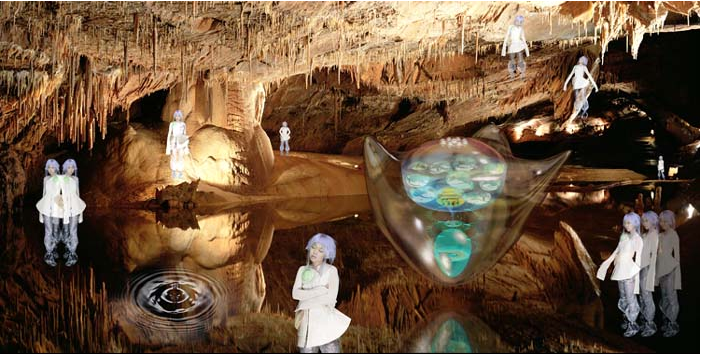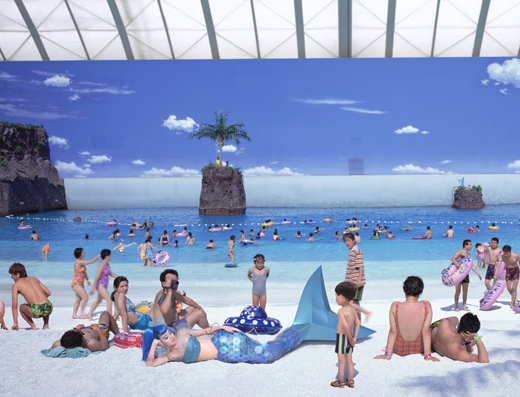Multiple artists left unforgettable imprints in human history through their artworks around the globe. The various phenomena, themes, and concepts are depicted through such works (Jacob & Mary Jane). This writing also focuses on a fabulous image with various dimensions of meaning and concepts. This paper will explore the basic biographical features and overall depiction of this image in alliance with the research-based comparison of the same image with another artwork of the same artist adorned with analysis features.
Mirror of Water
Biography & Basic Information:
The image under consideration was created in the time span of 1996-1998 as stated by Myarticles. The overall situation of this period relates to the end of the cold war, and the world was preparing towards a single power ambiguity. In other words, confusion and hesitant phase in world affairs were dominated when Mariko Mori created this masterpiece. She is a renowned multidisciplinary artist for her matchless works around the globe, having her origin roots in Japan. She is well versed in her photographs along with videography (Weilandt & Joerdis). Her works mainly depict and explore technology themes embedded with spirituality. Most of her early works revolve around Japanese culture and ancient history enveloped with a futuristic and spiritual sense.
However, the “Mirror of Water” was photographed in a cave located in France. It is a representation through the water of a time span of millions of years. The image looks like to suggest continuity of life with multiple phases by using the artist’s image at multiple places. The mirror of water is the most outstanding artwork with a mixture of multiple features.
Formal Analysis of Image:
The image contains consistent and continuous visual aspects that are interconnected like multiple branches. In this context, the artist has utilized her portrait in a repeated pattern. Multiple grim and solid colors of dense seriousness are shown in the image with multiple shades of water layers. The shadow techniques with duplexed and triplex portraits of the artist are meaningfully placed at various image points. Meanwhile, the entrance and exit points of the cave are undefined in the image. The cave depicts this world where the entrance and exit are not defined and not based on persons’ will. Multiple pictorial representations of the portrait show the continuity of life phases, including birth, death and rebirth, with a futuristic theme.
Moreover, the photograph is the combination of multiple colors along with the features of every minute to vast canvas and deeply thought-provoking. The color combination depicts the earthly environment at the initial phases of natural harmony along with the white-dressed human being. The white-dressed creature shows the deep sense of spirit world those lands on the earth with piousness and innocence as her primary characteristics. The dynamic and static water, along with the duplex, a triple face of human spirits, are shown with the ups and downs positions. These high or low positions are, in fact, depiction of human life with multiple circumstances with low and high moral or maybe status in the society or more profound sense depicts the spiritual voyage of sprits according to their piousness and performance on this soil-filled earth.
Research about Meaning of the Image:
This endless cycle and phases are not under the control of human beings, and the same is represented in the picture. Similarly, duplex and triplex images may manifest more than one theme at a time. Along with the life phases in a specific context, the picture portrays the variation in life on this earth. Human life advances on this earth with multiple time spans with many duties to be performed. Naturally, it is the uniqueness of the human life cycle that a man represents himself as more than one entity at a time. For example, at one stance, one is decorated with relations, and at the same time, he has to perform various duties and claim multiple rights with all the other objects of nature in alliance with human beings. In other words, human beings have multiple facets simultaneously during this life cycle on this earth. The same is depicted in the picture with multiple faces at some points in the cave, .i.e., the life of this earth where entrance and exit is out of control on the human side. In a nutshell, the elements of the photographic work describe the life cycle of human beings on this earth with multiple facets of performance and futuristic paradigms.
Moreover, various social, cultural and historical aspect and their respective impacts are shown in the picture. Historically, it depicts the origin of life on earth in ancient times in alliance with the social life with multiple status quo. Their impacts are out of bound of time. For example, the rise of humanity is shown as the scientific and technological development with the passage of time concerning the high and low position of portrait throughout the photograph.
Comparative Analysis & Conclusion:
As far as the comparative analysis is concerned, another pretty work is chosen, “Empty Dream”. There are several similarities and differences between these two photographs. Both depict watery images in a combination of earthly scenes and pictorial representations of human beings. In addition, prosperity is shown with the passage of time adorned with freedom of movement.
Empty Dream
Contrary to these, they are dissimilar to each other regarding various aspects. The “Empty Dream” represents bluish color depicting sky while the mirror of water goes on as earth image, both showing heavens-touched and earth life respectively. In the “Mirror of Water,” the portrait has multiple group pictures in a sequence of the same portrait, while “Empty Dream” does not follow such a pattern. In crux, we can say that Mariko Mori’s artwork is fabulous and depicts multiple dimensions of life aspects cyclically and spiritually.
Work Cited
Jacob, Mary Jane. Dewey for artists. University of Chicago Press, 2018.
Weilandt, Joerdis. “Mariko Mori.” Women in the World Today. Comparative Studies-Canada and Japan (2021).







